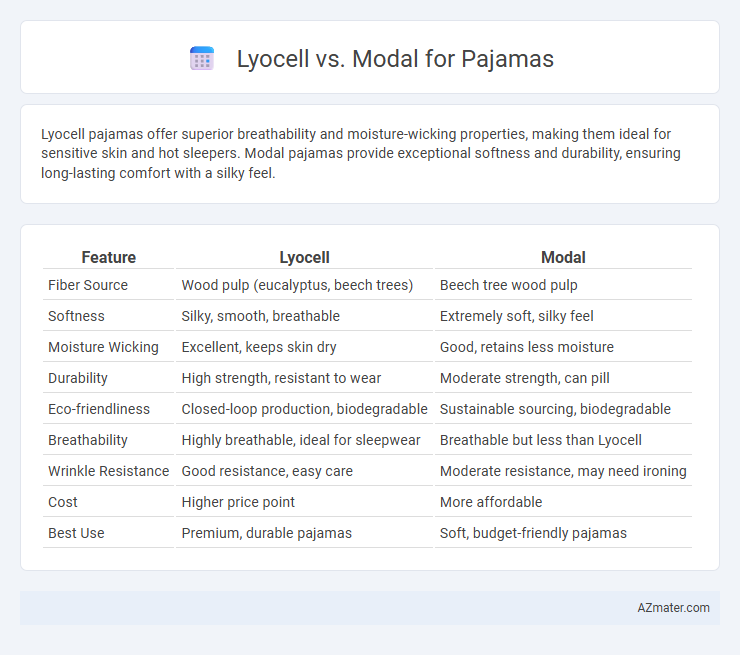Lyocell pajamas offer superior breathability and moisture-wicking properties, making them ideal for sensitive skin and hot sleepers. Modal pajamas provide exceptional softness and durability, ensuring long-lasting comfort with a silky feel.
Table of Comparison
| Feature | Lyocell | Modal |
|---|---|---|
| Fiber Source | Wood pulp (eucalyptus, beech trees) | Beech tree wood pulp |
| Softness | Silky, smooth, breathable | Extremely soft, silky feel |
| Moisture Wicking | Excellent, keeps skin dry | Good, retains less moisture |
| Durability | High strength, resistant to wear | Moderate strength, can pill |
| Eco-friendliness | Closed-loop production, biodegradable | Sustainable sourcing, biodegradable |
| Breathability | Highly breathable, ideal for sleepwear | Breathable but less than Lyocell |
| Wrinkle Resistance | Good resistance, easy care | Moderate resistance, may need ironing |
| Cost | Higher price point | More affordable |
| Best Use | Premium, durable pajamas | Soft, budget-friendly pajamas |
Introduction: Lyocell vs Modal for Pajamas
Lyocell and Modal are both sustainable, semi-synthetic fibers derived from wood pulp, widely used in making soft, breathable pajamas. Lyocell offers superior moisture-wicking properties and durability, making it ideal for temperature regulation during sleep. Modal excels in a silky smooth texture and exceptional color retention, enhancing comfort and aesthetic appeal in pajama fabrics.
What is Lyocell?
Lyocell is a sustainable fabric made from wood pulp, known for its softness, breathability, and moisture-wicking properties, making it ideal for pajamas that offer comfort and temperature regulation. Unlike Modal, which is semi-synthetic and derived from beech trees, Lyocell production uses a closed-loop process that recycles water and solvents, reducing environmental impact. The breathable structure of Lyocell fibers helps prevent overheating and ensures a smooth, silky feel against the skin, enhancing nighttime comfort in sleepwear.
What is Modal?
Modal is a type of semi-synthetic fabric made from beech tree pulp using a chemical process that produces a soft, smooth, and breathable textile ideal for pajamas. It offers excellent moisture-wicking properties and durability, making it a popular choice for comfortable sleepwear that feels gentle on the skin. Compared to lyocell, modal tends to have a slightly silkier texture and better elasticity, enhancing the fit and comfort of pajama garments.
Sustainability Comparison: Lyocell vs Modal
Lyocell pajamas are more sustainable than modal due to their environmentally friendly production process, which uses non-toxic solvents and a closed-loop system that recycles water and chemicals, minimizing waste and pollution. Modal, although biodegradable and made from beech tree pulp, often involves chemical treatments and energy-intensive processes that can have a higher environmental impact compared to lyocell. Choosing lyocell pajamas supports sustainable textile practices with lower water usage and reduced carbon footprint, making them an eco-conscious alternative in sleepwear.
Comfort and Softness for Pajamas
Lyocell pajamas offer exceptional breathability and moisture-wicking properties, making them highly comfortable for all-night wear. Modal pajamas are renowned for their ultra-soft, silky texture, providing a smooth and cozy feel against the skin. Both fabrics excel in softness, but Lyocell's natural fibers enhance durability and temperature regulation, ideal for sensitive skin and varying climates.
Durability and Longevity
Lyocell fiber boasts superior durability compared to Modal, maintaining strength and shape after multiple washes, making it ideal for long-lasting pajamas. Modal offers a soft, silky feel but tends to degrade faster, especially when exposed to heat and frequent laundering. Choosing Lyocell pajamas ensures extended wearability and sustained fabric resilience over Modal options.
Moisture Wicking and Breathability
Lyocell fabric offers superior moisture-wicking properties and exceptional breathability, making it ideal for pajamas that keep the skin dry and comfortable throughout the night. Modal, derived from beech trees, also provides good breathability but absorbs moisture more slowly than Lyocell, which can lead to a less drying effect. Both fibers are soft and eco-friendly, but Lyocell's advanced moisture management makes it a preferred choice for temperature regulation in sleepwear.
Care and Maintenance Requirements
Lyocell pajamas require gentle washing in cold water and low heat drying to maintain their softness and prevent shrinkage. Modal fabric demands similar care, with preference for cold machine wash and air drying to prolong fabric durability and color vibrancy. Both fibers benefit from mild detergents and avoiding bleach or fabric softeners to ensure longevity and comfort.
Price Differences
Lyocell pajamas generally come at a higher price point than modal due to the more sustainable and eco-friendly production process involving closed-loop solvents and minimal chemical usage. Modal pajamas are often more affordable, benefiting from mass production and a less intensive manufacturing process. Consumers seeking premium, environmentally conscious sleepwear may opt for lyocell despite its cost, while modal offers a budget-friendly alternative with similar softness and comfort qualities.
Which Fabric is Best for Pajamas?
Lyocell offers superior moisture-wicking and breathability, making it ideal for pajamas that keep you cool and comfortable throughout the night. Modal, derived from beech trees, provides exceptional softness and a silky feel, enhancing pajamas with a luxurious, smooth texture. For optimal sleepwear, Lyocell's durability and eco-friendly production make it the best choice, while Modal suits those prioritizing softness and a gentle touch against the skin.

Infographic: Lyocell vs Modal for Pajama
 azmater.com
azmater.com